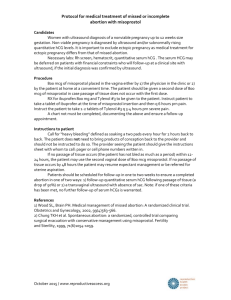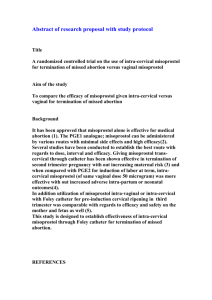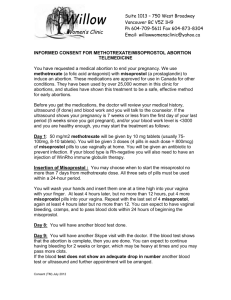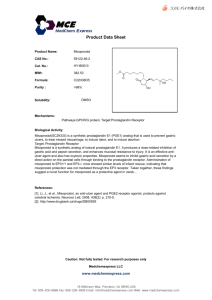Comparitive study of management of missed abortion with oral and
advertisement
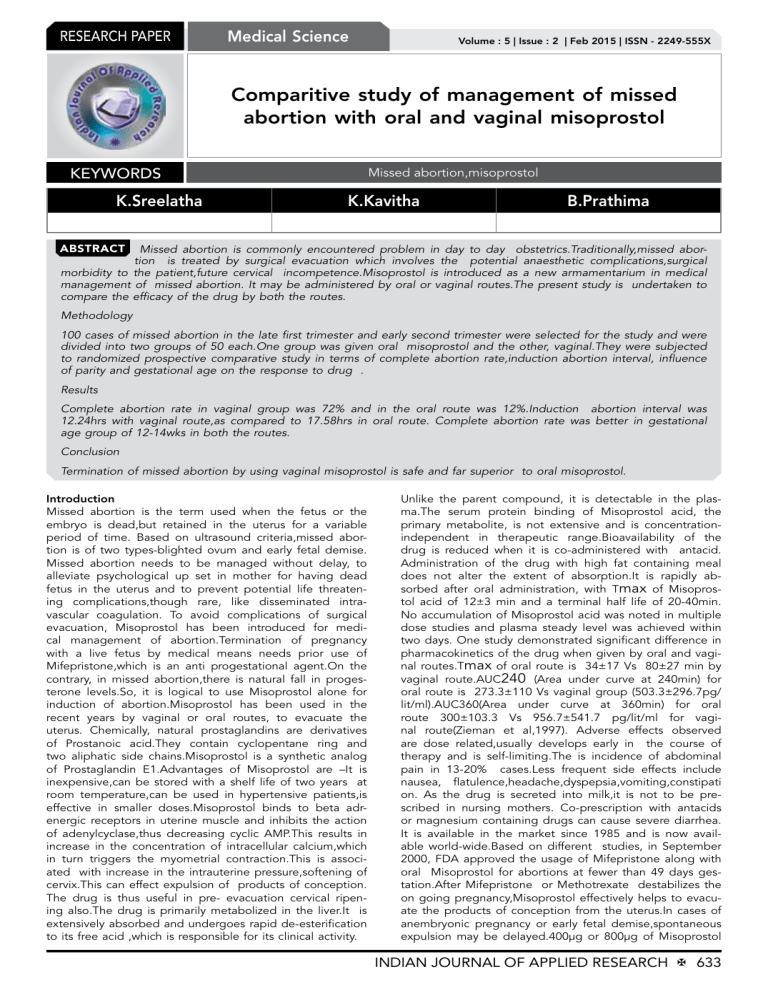
Research Paper Medical Science Volume : 5 | Issue : 2 | Feb 2015 | ISSN - 2249-555X Comparitive study of management of missed abortion with oral and vaginal misoprostol Keywords K.Sreelatha Missed abortion,misoprostol K.Kavitha B.Prathima ABSTRACT Missed abortion is commonly encountered problem in day to day obstetrics.Traditionally,missed abortion is treated by surgical evacuation which involves the potential anaesthetic complications,surgical morbidity to the patient,future cervical incompetence.Misoprostol is introduced as a new armamentarium in medical management of missed abortion. It may be administered by oral or vaginal routes.The present study is undertaken to compare the efficacy of the drug by both the routes. Methodology 100 cases of missed abortion in the late first trimester and early second trimester were selected for the study and were divided into two groups of 50 each.One group was given oral misoprostol and the other, vaginal.They were subjected to randomized prospective comparative study in terms of complete abortion rate,induction abortion interval, influence of parity and gestational age on the response to drug . Results Complete abortion rate in vaginal group was 72% and in the oral route was 12%.Induction abortion interval was 12.24hrs with vaginal route,as compared to 17.58hrs in oral route. Complete abortion rate was better in gestational age group of 12-14wks in both the routes. Conclusion Termination of missed abortion by using vaginal misoprostol is safe and far superior to oral misoprostol. Introduction Missed abortion is the term used when the fetus or the embryo is dead,but retained in the uterus for a variable period of time. Based on ultrasound criteria,missed abortion is of two types-blighted ovum and early fetal demise. Missed abortion needs to be managed without delay, to alleviate psychological up set in mother for having dead fetus in the uterus and to prevent potential life threatening complications,though rare, like disseminated intravascular coagulation. To avoid complications of surgical evacuation, Misoprostol has been introduced for medical management of abortion.Termination of pregnancy with a live fetus by medical means needs prior use of Mifepristone,which is an anti progestational agent.On the contrary, in missed abortion,there is natural fall in progesterone levels.So, it is logical to use Misoprostol alone for induction of abortion.Misoprostol has been used in the recent years by vaginal or oral routes, to evacuate the uterus. Chemically, natural prostaglandins are derivatives of Prostanoic acid.They contain cyclopentane ring and two aliphatic side chains.Misoprostol is a synthetic analog of Prostaglandin E1.Advantages of Misoprostol are –It is inexpensive,can be stored with a shelf life of two years at room temperature,can be used in hypertensive patients,is effective in smaller doses.Misoprostol binds to beta adrenergic receptors in uterine muscle and inhibits the action of adenylcyclase,thus decreasing cyclic AMP.This results in increase in the concentration of intracellular calcium,which in turn triggers the myometrial contraction.This is associated with increase in the intrauterine pressure,softening of cervix.This can effect expulsion of products of conception. The drug is thus useful in pre- evacuation cervical ripening also.The drug is primarily metabolized in the liver.It is extensively absorbed and undergoes rapid de-esterification to its free acid ,which is responsible for its clinical activity. Unlike the parent compound, it is detectable in the plasma.The serum protein binding of Misoprostol acid, the primary metabolite, is not extensive and is concentrationindependent in therapeutic range.Bioavailability of the drug is reduced when it is co-administered with antacid. Administration of the drug with high fat containing meal does not alter the extent of absorption.It is rapidly absorbed after oral administration, with Tmax of Misoprostol acid of 12±3 min and a terminal half life of 20-40min. No accumulation of Misoprostol acid was noted in multiple dose studies and plasma steady level was achieved within two days. One study demonstrated significant difference in pharmacokinetics of the drug when given by oral and vaginal routes.Tmax of oral route is 34±17 Vs 80±27 min by vaginal route.AUC240 (Area under curve at 240min) for oral route is 273.3±110 Vs vaginal group (503.3±296.7pg/ lit/ml).AUC360(Area under curve at 360min) for oral route 300±103.3 Vs 956.7±541.7 pg/lit/ml for vaginal route(Zieman et al,1997). Adverse effects observed are dose related,usually develops early in the course of therapy and is self-limiting.The is incidence of abdominal pain in 13-20% cases.Less frequent side effects include nausea, flatulence,headache,dyspepsia,vomiting,constipati on. As the drug is secreted into milk,it is not to be prescribed in nursing mothers. Co-prescription with antacids or magnesium containing drugs can cause severe diarrhea. It is available in the market since 1985 and is now available world-wide.Based on different studies, in September 2000, FDA approved the usage of Mifepristone along with oral Misoprostol for abortions at fewer than 49 days gestation.After Mifepristone or Methotrexate destabilizes the on going pregnancy,Misoprostol effectively helps to evacuate the products of conception from the uterus.In cases of anembryonic pregnancy or early fetal demise,spontaneous expulsion may be delayed.400µg or 800µg of Misoprostol INDIAN JOURNAL OF APPLIED RESEARCH X 633 Research Paper Volume : 5 | Issue : 2 | Feb 2015 | ISSN - 2249-555X Group I (V) Group II (O) Total 50 8 6 0 50 16 28 2 100 24 34 2 bleeding Excessive No Response abortions Table 2.Indication for surgical intervention Incomplete Material and methods The present study was carried out the department of Obstetrics and Gynaecology, Government general Hospital, Kurnool during the year 2008-2009.Hundred cases of Missed abortion were selected for the study.Detailed history and clinical examination of the case was followed by administration of the drug orally in 50 cases and vaginally in 50 radomly selected cases and prospective comparative study was done.Inclusion criteria were-both primigravidae and multigravidae with gestational age between 8-14weeks,hemoglobin above 8gm/dl.Exclusion criteria included-patients with ectopic pregnancy,prior caesarian section,allergy to prostaglandins,those with Cardiovascular disease,long term corticosteroid therapy,hemorrhagic disorders,on anticoagulant therapy,porphyrias,adrenal failure.Those with local active genital tract infection were also excluded. Surgical evacuation was done in cases with incomplete abortion or no response or in those who bled excessively. Only 2 cases of group II required surgical evacuation due to excessive bleeding, compared to none in group I.This difference was found to be not significant statistically.(Table 2) n oral or vaginal have been used(Goldber et al,2001). Methods of administration: Patients were randomly assigned to one of the two groups of route of administration. The induction abortion interval was studied in cases of complete abortion.The mean interval was 12.24hrs in group I, as compared to 17.58 hrs in Group 1(Vaginal Misoprostol) group II.This difference was found to be statistically significant(Table 3). Group I (V) Group II (O) Total 50 50 100 36(72%) 8 6 6(12%) 16 28 42 24 34 634 X INDIAN JOURNAL OF APPLIED RESEARCH 3 36 12.24 4.25 6 17.58 1.07 12-15 15-18 3-6 6-9 9-12 2 No response 8 7 abortions 0 4 Incomplete abortions 5 4 9 n Complete 0 0 0 Table 1.Response Group I Results The outcomes of two routes of administration is compared with reference to response, i.e, complete abortion,incomplete abortion,induction-abortion interval and side effects. No discrepancy was observed between two groups,with regards to age,gestational age and parity. Out of 50 cases of group I,36 aborted completely, 8 had incomplete abortion and 6 did not respond at all.Out of 50 cases of group II, only 6 had complete abortion, 16 had incomplete abortion, 28 did not respond at all.The difference in the response of the two groups was statistically significant.Patients who did not respond,also had some good outcome in the form of cervical ripening,which helped surgical evacuation.They had minimal blood loss during the procedure(Table 1). Group II Administration protocol for the drug and monitoring were similar to group I,but for the route,which was oral.Maximum number of doses given was six.Cases which did not respond even after completion of 6 doses and those who experienced heavy bleeding underwent surgical evacuation. Number of complete abortions in the time interval(in Hrs) Group 2(Oral Misoprostol) I-A interval in hrs Mean SD Total no. of complete abortions Table 3.Induction abortion interval time distribution >18 Tablet Misoprostol is available in dosage of 100 and 200µg.One tablet of 200µg was placed vaginally and the same was repeated every 3hrs, till any of the following outcome was observed-expulsion of products of conception or excessive bleeding per vaginum.Ultrasonography was done to confirm the completion of abortion. Influence of gestational age on induction-abortion interval was studied. It was observed that cases in the 8-10wk and 10-12wks responded similarly,but those between 12-14wks had slightly higher interval.Response to induction increased almost linearly with increase in gestational age,though the interval was slightly prolonged. Research Paper It was observed that response in terms of complete abortion was higher in primigravidae as compared to multigravida, particularly in the oral group. Discussion : The efficacy of Misoprostol in the termination of late first trimester and early second trimester abortions has been studied.A maximum of 1200µg has been administered in 6 divided doses of 200µg each , 3rd hourly.Earlier, some studies used a maximum dose of 2400µm administered in three divided doses of 300µg each,at an interval of 24hrs.With such a dosage, the peak plasma concentration obtained though high,compared to lower dose,remain so for 4-6 hrs only.Later, the plasma levels fall to very low levels(Tang etal,2002a).On the contrary, in the dosage administered byus,though the peak level is not as high,the level is sustained for a longer period due to 3rd hourly repetition.With this dose, the side effects like nausea,vomiting,prolonged bleeding,fever,chills and diarrhea as observed in the other protocol, were minimized. There was a study on usage of vaginal Misoprostol for induction of abortion,which used a dosage of 200µg used 8th hourly for 6 doses(Koopersmith 1996). Response was observed in 50% of the cases.Another group used same dosage 12th hourly for 4 doses.They observed response in 46% of the cases.The number of cases which responded was higher in our study(72%).Induction-abortion interval was compared with that observed in other studies. Mean value was 12.24±4.25hrs in our study,as compared to 8.0±3.4hrs(Esteve1999),7.4±3.8hrs(Carbonell 1997).Both these studies also used a maximum dosage of 2400µg in divided doses,which was higher than the dosage used Volume : 5 | Issue : 2 | Feb 2015 | ISSN - 2249-555X in our study. Significantly high rates of side effects of nausea,diarrhea,vomiting,fever, and chills were reported in majority of the studies with higher doses of Misoprostol.Side effects were observed in very few cases in our study.2 women in group II(O) had excessive bleeding and required surgical evacuation.4 women of group II had complaint of nausea.3 women in group I(V) and 2 women in group II (O) had abdominal pain. Misoprostol is absorbed through the vaginal mucosa in vaginal administration.It is closer to the site of action.The response to oral group is low since the drug has first pass effect through liver.In most of the studies, vaginal route has been used.Also, in the present study,the side effects are minimal in the two routes of administration. Conclusion : The complete abortion rate (72%)was significantly higher in vaginal compared to oral group.There was significantly lower Induction-abortion interval in vaginal(12.24hrs) compared to oral(17.58hrs) route.Complete response rate was higher in cases of early second trimester in both the groups,though the time taken was slightly higher. The frequency of occurance of side effects was found to be minimal and they were only of minor severity. Moreover,Misoprostol is an inexpensive drug,can be stored at room temperature and has a longer shelf life.Vaginal route is far superior compared to oral group in terms of blood loss,completeness of abortion and,induction-abortion interval.It is associated with less morbidity to the patient. REFERENCE 1.Carbonell J L L.,Varela L.,Velazco A,et al (1997)The use of misoprostol for termination of early | | pregnancy.Contraception,55,165-168. | | 2.Esteve Carbonell J L.,Varela L.,Velazco A.,et al(1998)Vaginal misoprostol for late first trimester | | abortion.Contraception,57,329-333. | | 3.Esteve J L.,Varela L.,Velazco A.et al(1999)Early abortion with 800µm of misoprostol by vaginal | | route.Contraception,59,219-25. | | 4.Goldberg A B.,Mara B.,Greenberg B S,et al(2001)Misoprostol and pregnancy.The New England | | Journal of Medicine,344,38-47. | | 5.Goodman and Gilman’s The Pharmacological basis of Therapeutics. Macmillan Publishing | | Company. | | 6.Koopersmith T B.,Mishell D R.The use of misoprostol for termination of early pregnancy. | | Contraception 1996;57:237-242. | | 7.Tang O S.,Schweer H.,Seyberth H W .et al.(2002a)Pharmacokinetics of different routes of | | administration of misoprostol.Human reproduction,17,332-335. | | 8.Zieman M.,Fong S K.,Benowitz N L et al.(1997)Absorption kinetics of misoprostol with oral | | or vaginal administration.Obst.Gynaecol.,90,88-92. | INDIAN JOURNAL OF APPLIED RESEARCH X 635
